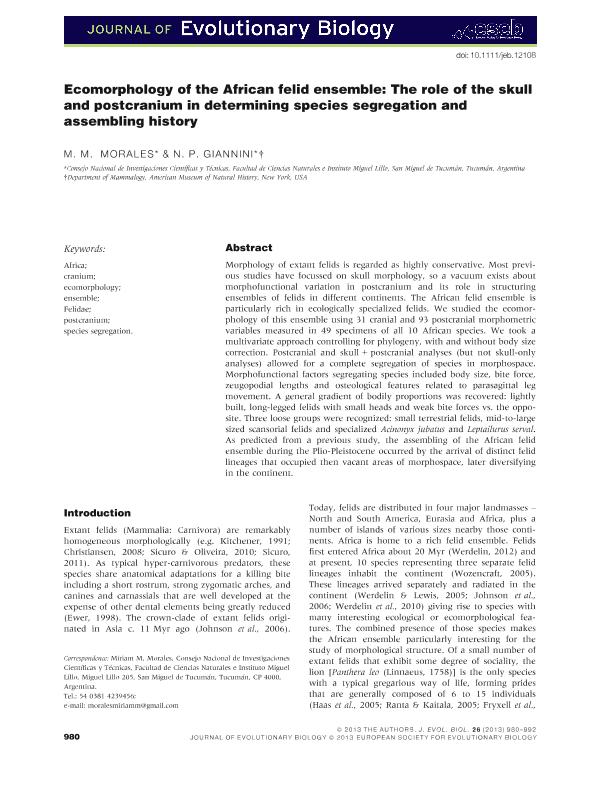Artículo
Ecomorphology of the African felid ensemble: the role of the skull and postcranium in determining species segregation and assembling history
Fecha de publicación:
01/2013
Editorial:
Wiley
Revista:
Journal Of Evolutionary Biology
ISSN:
1010-061X
Idioma:
Inglés
Tipo de recurso:
Artículo publicado
Clasificación temática:
Resumen
Morphology of extant felids is regarded as highly conservative. Most previous studies have focussed on skull morphology, so a vacuum exists about morphofunctional variation in postcranium and its role in structuring ensembles of felids in different continents. The African felid ensemble is particularly rich in ecologically specialized felids. We studied the ecomorphology of this ensemble using 31 cranial and 93 postcranial morphometric variables measured in 49 specimens of all 10 African species. We took a multivariate approach controlling for phylogeny, with and without body size correction. Postcranial and skull + postcranial analyses (but not skull-only analyses) allowed for a complete segregation of species in morphospace. Morphofunctional factors segregating species included body size, bite force, zeugopodial lengths and osteological features related to parasagittal leg movement. A general gradient of bodily proportions was recovered: lightly built, long-legged felids with small heads and weak bite forces vs. the opposite. Three loose groups were recognized: small terrestrial felids, mid-to-large sized scansorial felids and specialized Acinonyx jubatus and Leptailurus serval. As predicted from a previous study, the assembling of the African felid ensemble during the Plio-Pleistocene occurred by the arrival of distinct felid lineages that occupied then vacant areas of morphospace, later diversifying in the continent.
Palabras clave:
Africa
,
Cranium
,
Ecomorphology
,
Ensemble
,
Felidae
,
Postcranium
,
Species Segregation
Archivos asociados
Licencia
Identificadores
Colecciones
Articulos(CCT - NOA SUR)
Articulos de CTRO.CIENTIFICO TECNOL.CONICET - NOA SUR
Articulos de CTRO.CIENTIFICO TECNOL.CONICET - NOA SUR
Articulos(SEDE CENTRAL)
Articulos de SEDE CENTRAL
Articulos de SEDE CENTRAL
Citación
Morales, Miriam Mariana; Giannini, Norberto Pedro; Ecomorphology of the African felid ensemble: the role of the skull and postcranium in determining species segregation and assembling history; Wiley; Journal Of Evolutionary Biology; 26; 5; 1-2013; 980–992
Compartir
Altmétricas




